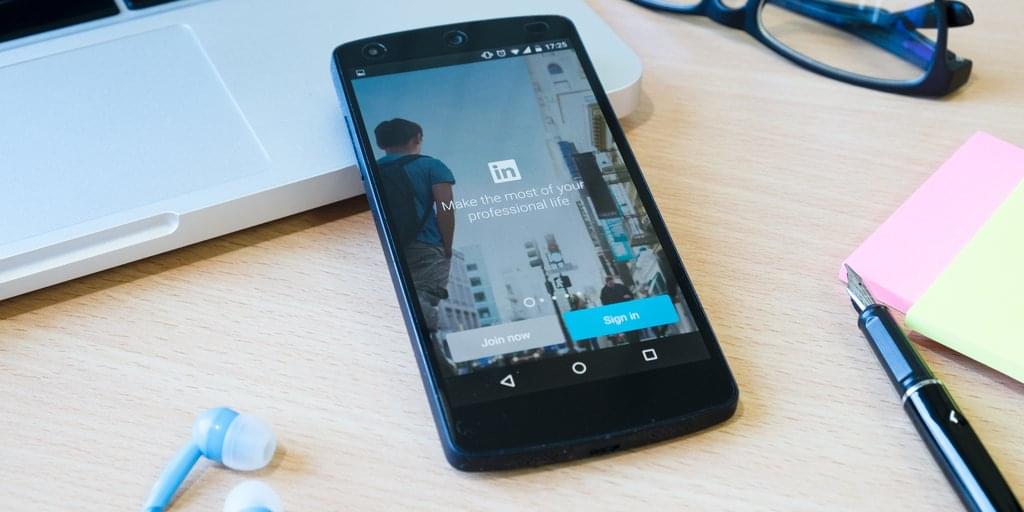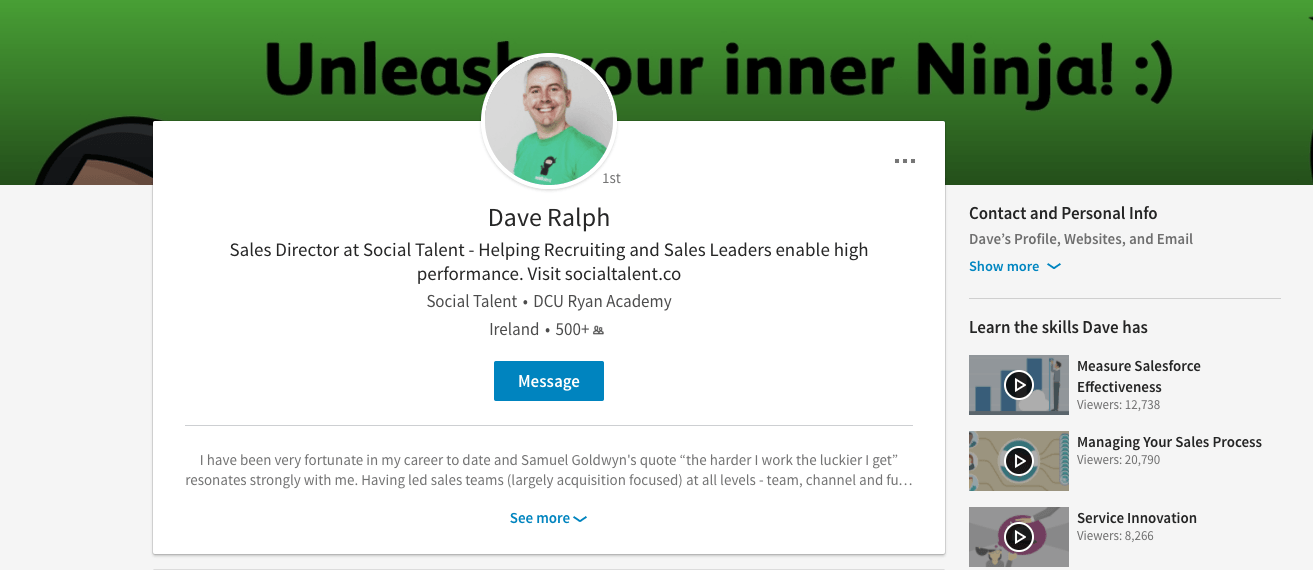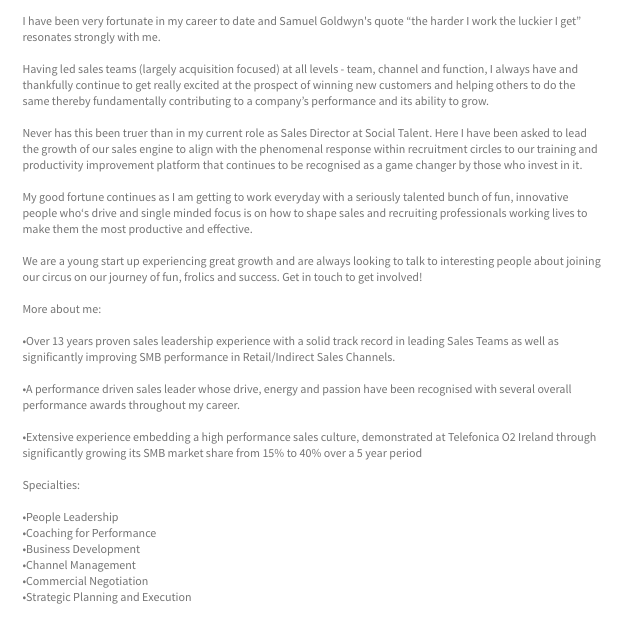4 Reasons Why LinkedIn Is The Perfect Prospecting Tool

LinkedIn has generally been known as the recruiters secret weapon when setting out to search for new candidates. However, LinkedIn is also the perfect tool when finding and qualifying new prospects. More and more sales professionals are turning to LinkedIn due to its vast amount of business professionals – which means that there’s plenty of opportunities to sell! In this blog we’ll take a look at 4 ways you can take to improve your sales approach, so that you can start turning opportunities into hard earned cash.
1. Make your profile stand out
First things first, it’s important that your LinkedIn profile is fully optimised. People aren’t going to commit to buying anything from you if they’re staring at a blank canvas of nothingness. Show your prospects that you’re the real deal! It’s important to frame the way you want to be perceived. Remember, you aren’t just your business card, you’re everything on and offline. Fill in every fine detail until you find yourself with a LinkedIn profile that’s 100% filled out. Fill in the finer details and make sure that your LinkedIn headline automatically connects with people the minute they visit your profile.

Outline what you do in a short concise sentence. Again, make it stand out! Use positive wording that showcases what yo and the company you work for do. Steer clear of being boring, and aim to captivate your audience. You want people to immediately understand what you do, the second they visit your profile. In addition, make sure your LinkedIn summary reads well. Don’t litter it with your daily tasks or jargon filled industry terms. Make it easy on the eye, and don’t forget to list your own personal accomplishments as well as the company you work for. If you don’t write it then no one will ever know!

2. Join groups with fellow sales professionals
Joining groups on LinkedIn is not only useful for keeping up-to-date with the latest trends in your industry, but it also allows you to connect with potential prospects. Ensure that you research what groups your customers are following, as well as your potential prospects.This way you can reach out to them using a simple Inmail. Not only will you learn from the groups that you join, but joining a group will allow you to engage with your prospects. Get involved in a discussion, ask a question or add your own valuable insight. There are many ways in which you can interact.
 Make sure that you are active. The more active you are, the more people will begin to notice you. Rome wasn’t built in a day, so getting to work on building a foundation ASAP is essential. Only join groups that you think will benefit you either. Will the group make you a better salesperson? Do you think you’ll find more customers? If so, then don’t think twice – Join! Choose 2-3 groups that you will post in consistently. The aim of all this is become a thought leader. Someone that offers valuable insight and information. This ultimately builds your reputation and in turn, will result in people placing their trust in you. The more trustworthy you are, the more likely people are to buy what you’re selling.
Make sure that you are active. The more active you are, the more people will begin to notice you. Rome wasn’t built in a day, so getting to work on building a foundation ASAP is essential. Only join groups that you think will benefit you either. Will the group make you a better salesperson? Do you think you’ll find more customers? If so, then don’t think twice – Join! Choose 2-3 groups that you will post in consistently. The aim of all this is become a thought leader. Someone that offers valuable insight and information. This ultimately builds your reputation and in turn, will result in people placing their trust in you. The more trustworthy you are, the more likely people are to buy what you’re selling.
3. Use LinkedIn’s sales navigator
If you have a premium account, you will find that you have full access to use LinkedIn’s Sales Navigator. However, it’s only worth the money if you have a clear-cut plan on how you’re going to go about selling. Using the sales navigator, you’ll be able to view more prospects faster. Understand the message that you’re trying to get across. This is especially important when it comes to Inmailing prospects. Make sure that your Inmail doesn’t come off as spammy. LinkedIn keep a close eye on your reputation score, and if you’ve exceeded the amount of times you can be reported, then you’re outta there!
 It’s true that most sales professionals misuse their premium accounts as well as the sales navigator. A common mistake made by sales professionals is that they concentrate on their own needs rather than that of their customers. This makes it automatically look like a sales pitch when reaching out to prospects, and this really frustrates users. The sales navigator also offers excellent insights, as well as having a unique algorithm that offers you the best prospects with regards to what you’re selling. Also, understand the needs of your customers with real-time sales updates.
It’s true that most sales professionals misuse their premium accounts as well as the sales navigator. A common mistake made by sales professionals is that they concentrate on their own needs rather than that of their customers. This makes it automatically look like a sales pitch when reaching out to prospects, and this really frustrates users. The sales navigator also offers excellent insights, as well as having a unique algorithm that offers you the best prospects with regards to what you’re selling. Also, understand the needs of your customers with real-time sales updates.
4. Connect with past customers
After you’ve sealed the deal, make the attempt to reach out to the customer and ask them if they would like to connect. What do you have to gain from this? Well if it’s a case of you providing them with an excellent service and that they’re a very happy customer, then they might send more people your way. If someone has a positive experience with you, they are more likely to recommend you to someone else. When inviting them to connect with you on LinkedIn, make sure that your personalise your message. Don’t come across as a chatbot or some robot. You want your customers to remember you, so give them a valid reason!
 Remember also, the more contacts you have the more opportunities that are created. If you have news or want to highlight an important update regarding your service/product, you no doubt want to reach as many people as possible. On the other hand, don’t add people for the sake of it. Work hard in building a reputation and connect with those who you feel could be valuable assets. Explain from the start why it is you want to connect them, and like the Inmails, make sure that you’re not pitching to them.
Remember also, the more contacts you have the more opportunities that are created. If you have news or want to highlight an important update regarding your service/product, you no doubt want to reach as many people as possible. On the other hand, don’t add people for the sake of it. Work hard in building a reputation and connect with those who you feel could be valuable assets. Explain from the start why it is you want to connect them, and like the Inmails, make sure that you’re not pitching to them.
To find out more about the psychology of pricing and other sales insights request a demo of our Social Selling online learning platform!
